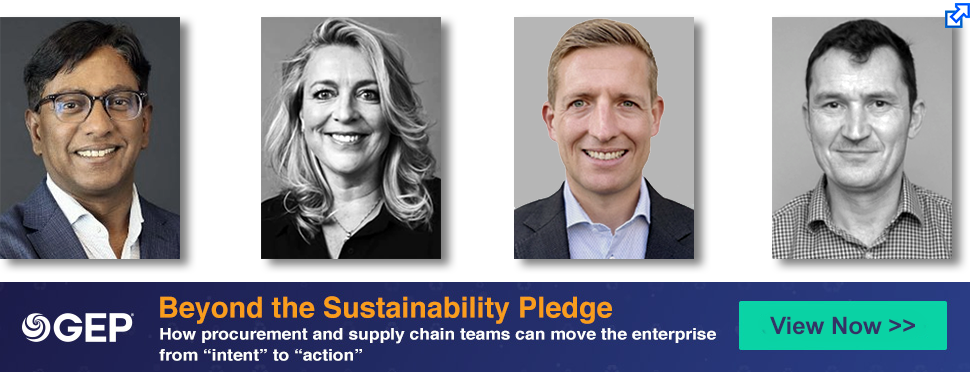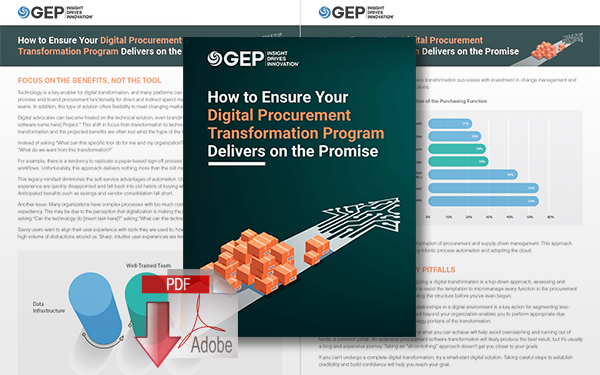Environmental, Social, Governance, and Procurement - It’s Time to Take Charge

While ESG has been a board-level topic for many years, leaders have only recently woken up to the need to act.
ESG and Procurement - It's Time to Take Charge
On paper, enterprises proudly tout their corporate responsibility efforts. In reality, environmental, social, and governance (ESG) practices are almost always pitted against an organization’s core goal of ensuring the bottom-line impact of procurement and supply chain activities.
While ESG has been a board-level topic for many years, leaders have only recently woken up to the need to act.
Tackling this challenge requires procurement to take a seat at the corporate ESG table.
Why Is Corporate Sustainability More Important Than Ever?
Simply stated, ESG practices combine elements of people, planet, and profitability while being governed by internal systems of practices, controls, and procedures.
Although enterprises have traditionally had difficulty financially justifying ESG activities, the facts now present a very different picture.
Consumer Behavior
In the International Trade Centre (ITC) survey of retailers in large European markets, 85% reported an increase in sales of sustainable products in the past five years, and 92% said they expect these sales to increase in the next five years. (1)
Consumers’ demand for sustainable products now leaves organizations with little choice but to prioritize ESG goals and provide visibility into their procurement and supply chain activities. Apple, Dell, and HP are sobering examples of the backlash enterprises can face for sourcing electronics from suppliers that expose workers to hazardous conditions. Nike and Adidas, too, suffered the same fate for working with suppliers who polluted rivers in China.
According to EcoVadis, 61% of procurement leaders say ESG issues such as diversity and equity will become “more important” or “significantly more important” over the next two to three years. This is because of the glare of public scrutiny brought about by social media, among other factors, which has made ESG a prerequisite to maintaining and enhancing brand value and consumer loyalty, both of which directly impact revenue. (2)
Activist Investors
The emergence of activist investors is also forcing enterprises to improve their ESG performance. These investors, like consumers, make choices based on multiple ESG metrics and call for higher levels of transparency.
For example, firm-level ESG selection strategies represented a total of €10.7 trillion or 45% of assets under management in 2019, a figure that we believe has only grown. (3) Moreover, enterprises that disclose their climate footprint lower their cost of capital by up to 10% because of increased levels of investor trust. (4)
Government Interventions and a Changing Legal Landscape
Governments are also playing a role in driving an ESG agenda in both public and private sectors, especially in Europe.
For example, the European Green Deal aims to curb the negative ESG impact on businesses. (5) In Belgium, enterprises received tax benefits of 120% for using electric vehicles in their fleets until 2019 and the rate was slightly reduced in 2020.
Companies also received a 75% income tax deduction on the cost of charging these vehicles. (6)
The EU’s Green Public Procurement (GPP) is focused on driving ESG in public procurement activities. Under this plan, Mechelen in Belgium estimates energy savings of over 50,000 kWh per year by following low energy and circular economy protocols. In addition, government interventions and incentives on ESG continue to drive cost savings. (7)
Supply Chain Resilience
ESG practices also contribute to a more resilient supply chain.
The pandemic exposed weaknesses in many enterprises’ global supply chains, especially those that were heavily reliant on single-source, third-party, or overseas suppliers. ESG practices in procurement activities can improve supply chain resiliency.
For instance, an innovation-driving circular economy can make corporations less reliant on raw materials from third parties.
Nearshoring with alternate suppliers can prevent businesses from facing delays while reducing greenhouse gas (GHG) emissions. The importance of ESG challenges is also outlined in EcoVadis’ Sustainable Procurement Barometer, which shows that delivering on ESG goals has shifted to the top of the executive agenda and that sustainable procurement initiatives helped a significant proportion of organizations endure the pandemic. (8)
Where Does Procurement Fit Into Corporate ESG?
Given procurement’s scope of impact, it can play a central role in bringing value to the business by driving ESG initiatives within procurement activities. The largest opportunity for companies to meet their ESG targets is in their supply chain.
Procurement is well-positioned to achieve ESG targets by working with its first, second, and third-tier suppliers.
Supply chain emissions are on average 5.5 times as high as a corporation’s direct emissions, (9) which suggests that a significant proportion of an organization’s carbon emissions can be traced back to its supply chain, often to suppliers over whom the organization has little visibility. These are also known as suppliers from an organization’s “Scope 3 emissions.” (10)
For example, Network Rail worked with Carbon Intelligence to quantify its emissions and found that two-thirds of its emissions were in its supply chain. (11) By setting science-based sustainability targets with their suppliers, Network Rail aims to trigger a domino effect that will reduce supply chain-related emissions by about 50% by 2030. This effort will help bring the UK closer to its 2050 net-zero target.
How Can Procurement Play A Key Role In Achieving ESG Targets?
Procurement’s roles and responsibilities make the function key in driving cross-functional collaboration to achieve overall ESG targets and increase competitiveness.
- Procurement needs to reimagine costs and create a mindset shift across the organization: Reimagining cost means focusing on the Total Value of Ownership (TVO) instead of the traditional lens of Total Cost of Ownership (TCO). The TCO perspective leads organizations to make decisions based on bottom-line impact, enabling businesses to prioritize value over monetary costs of creating new opportunities.
- Procurement KPIs should be redefined with cross-functional collaboration: For example, Procurement should engage with Marketing to quantify impacts on brand and reputation, with HR to quantify improvements in employee wellbeing and satisfaction, and with Sustainability to quantify benefits in GHG reductions. A combination of these KPIs will help quantify the intangible benefits of achieving ESG commitments (or the costs of no action).
- Procurement should develop and implement an ESG framework: A framework for category management, sourcing, supplier relationship management, and data management will allow procurement to embed ESG into their practices.
References
- “The European Union Market for Sustainable Products: The retail perspective on sourcing policies and consumer demand,” International Trade Centre, European Commission, May 2019
- Charlie Hart, “Reputational risk overtaking legal and compliance,” cips.org, 20 Nov 2019
- Tomas Tillay, Dominik Hatiar, “EFAMA publishes report on level and nature of sustainable investment by the European asset management industry” European Fund and Asset Management Association, 19 Nov 2020
- Gianfranco Gianfrate, Dirk Schoenmaker, Saara Wasama, “Cost of capital and sustainability: A literature review,” Rotterdam School of Management Erasmus University
- “A European Green Deal: Striving to be the first climate-neutral continent,” European Commission
- “Alternative fuels in Europe,” European Alternative Fuels Observatory
- “Why sustainable & circular public procurement?,” Sustainable Procurement Platform
- “Sustainable procurement barometer 2021,” Ecovadis, 29 July 2021
- “Supply chains hold the key to one gigaton of emissions savings, finds new report,” CDP, 9 Dec 2019
- Hannah Morris, “The importance of the supply chain in setting Net Zero targets,” Carbon Intelligence, 18 May 2021
- Grace Melville, “Tackling Network Rail’s supply chain,” Carbon Intelligence, 24 May 2021
Webinar Beyond The Sustainability Pledge: How Procurement And Supply Chain Teams Can Move The Enterprise From “Intent” To “Action”.
Available On-Demand
ESG goals are top of the agenda. Corporate social responsibility, diversity, risk, and impact in the supply chain all present us with a huge complexity of issues. While we might be fully behind the board-level pledge to do better, how can we in procurement and supply chain operations move beyond being “less bad” and make measurable progress to our ESG goals?
In this webinar, a panel of experts from GEP, Jagadish Turimella, COO & Co-Founder, GEP | Monique Alblas, VP Consulting, GEP | Jille Luijckx, VP Global Delivery, GEP in conversation with David Rae - Chief Product Officer, Procurement Leaders (pictured below) will discuss the ESG challenges facing organizations, specific innovations in strategy, operations, and technology that are designed to help companies shift from intent to action, and identify what can be adopted right now to begin to drive results.
Related Resources
6 Steps for Procurement to Drive Environmental, Social, Governance Excellence for the Enterprise
This white paper, 6 Steps for Procurement to Drive ESG Excellence for the Enterprise, lists the effective methodologies and expertise procurement leaders can equip their teams with to develop and implement ESG frameworks and unlock competitive advantage. Download Now!
How to Ensure Your Digital Procurement Transformation Plan Delivers on the Promise
How to Ensure Your Digital Procurement Transformation Program Delivers on the Promise highlights the steps CPOs need to take to ensure their transformation plans don’t flop. In addition, get valuable advice on avoiding pitfalls with a top-down approach. Download Now!
More Resources from GEP
Article Topics
GEP News & Resources
GEP Procurement & Supply Chain Tech Trends Report 2024 How Procurment and Supply Chain Leaders Should Handle Supply Chain Disruptions Optimizing Business Outcomes by Investing in Sustainable Supply Chains and Procurement Optimizing Direct Material Sourcing with a Unified, Extensible Source-to-Pay Platform Generative AI in Procurement Navigating the Cost-Plus World of Supply Chains How to Avoid the Pittfalls of Contract Management in Telecom and High-Tech More GEPLatest in Supply Chain
TIm Cook Says Apple Plans to Increase Investments in Vietnam Amazon Logistics’ Growth Shakes Up Shipping Industry in 2023 Spotlight Startup: Cart.com is Reimagining Logistics Walmart and Swisslog Expand Partnership with New Texas Facility Nissan Channels Tesla With Its Latest Manufacturing Process Taking Stock of Today’s Robotics Market and What the Future Holds U.S. Manufacturing Gains Momentum After Another Strong Month More Supply Chain

















